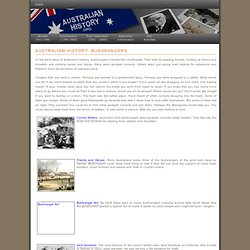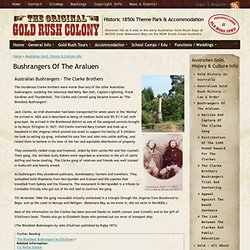

Ancient Australian History. In the early days of Australia’s history, bushrangers roamed the countryside.

They lived by stealing horses, holding up farms and travelers and robbing banks and stores. Many were escaped convicts. Others were just young men looking for adventure and freedom from the boredom of everyday work. Imagine that you were a convict. Perhaps you worked in a government gang. Convict Bolters: Australia's first bushrangers were escaped convicts called 'bolters' They fled into the bush and survived by stealing from settlers and travellers. Friends and Heroes: Many Australians today think of the bushrangers of the gold rush days as heroes. Bushranger Act: By 1830 there were so many bushrangers roaming around New South Wales that the government passed a special Act to make it easier to catch people who might be bush- rangers. Jack Donohue: The most famous of the convict bolters was Jack Donahue, an Irishman who arrived in Sydney in 1825, aged eighteen.
Australian Bushrangers. Australian gold rushes. An Australian gold diggings circa 1855 After the California gold rush began in 1848, causing many people to leave Australia for California to look for gold there, the New South Wales government rethought its position, and sought approval from the Colonial Office in England to allow the exploitation of the mineral resources and also offered rewards for the finding of payable gold.[2] The first gold rush in Australia began in May 1851 after prospector Edward Hargraves claimed to have discovered payable gold near Bathurst, at a site he called Ophir.[3] Hargraves had been to the Californian goldfields and had learned new gold prospecting techniques such as panning and cradling.

BUSHRANGERS. Australian Bushrangers. Bushranger. History[edit] More than 2000 bushrangers are believed to have roamed the Australian countryside, beginning with the convict bolters and drawing to a close after Ned Kelly's last stand at Glenrowan.[3] 1850s: gold rush era[edit] The bushrangers' heyday was the Gold Rush years of the 1850s and 1860s as the discovery of gold gave bushrangers access to great wealth that was portable and easily converted to cash.

Their task was assisted by the isolated location of the goldfields and a police force decimated by troopers abandoning their duties to join the gold rush.[3] George Melville was hanged in front of a large crowd for robbing the McIvor gold escort near Castlemaine in 1853.[3] 1860s to 1870s[edit] Bushranging numbers flourished in New South Wales with the rise of the colonial-born sons of poor, often ex-convict squatters who were drawn to a more glamorous life than mining or farming.[3] Ned Kelly. 1907_ABC1_Education_Schools_Opener_hi.flv ABC TV Education Watch our new on-air promotion Seeking Refuge This BAFTA Children's Award winner is a compelling and moving series of short animated documentaries portraying the real-life stories of young people who have sought asylum.

Find out more Lockie Leonard Through the eyes of Lockie Leonard we view the truly mixed-up, yet very normal life of Lockie, his family and friends. Being Chinese Shot entirely on location in Beijing, this programme follows a group of Chinese children through their daily lives. The ABC has been providing an Education TV service for over forty years. ABC TV Education Programming is committed to providing content that not only meets the ABC's Editorial Standards and Code of Practice, but also the Australian National Curriculum.
Australian Gold, History & Culture Info - Historic Gold Rush Village Mogo South Coast NSW Australia. The murderous Clarke brothers were worse than any of the other Australian bushrangers, outdoing the notorious Ned Kelly, Ben Hall, Captain Lightning, Frank Gardiner and Thunderbolt.

The Clarke and Connell gang became known as "The Bloodiest Bushrangers". Jack Clarke, an Irish shoemaker had been transported for seven years in the "Morley". He arrived in 1826 and is descirbed as being of medium build and 5ft 51/4 tall with grey eyes. He arrived in the Braidwood district as one of the assigned convicts brought in by Major Elrington in 1827. Old Clarke married Mary Connell and took up a leasehold in the Jingeras which proved too small to support his family of 5 children. They constantly raided crops and livestock, aided by their uncles Pat and Tom Connell. As bushrangers they plundered publicans, storekeepers, farmers and travellers.
Till November 1866 the gang marauded virtually unchecked in a triangle through the Jingeras from Braidwood to Bega, and up the coast to Moruya and Nelligen. Australian Crimes - BUSHRANGERS.